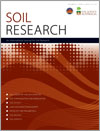Using distributions of heavy metals in soil sourced from semivariograms provided in published studies, the current study provided broad sample size guidelines for estimating mean contamination, and mapping contamination at a site. For estimating the mean concentration, 2–4 samples were estimated for most of the selected studies. For mapping a contaminated site, the lowest uncertainty was achieved around 500 samples for the selected studies.

Soil Research
Volume 57 Number 4 2019
Cereal root disease caused by the soil-borne pathogen Rhizoctonia results in large economic losses for dryland farmers in Australia and worldwide. This study demonstrated that organic matter input to soil can reduce root disease by enhancing a suite of soil organisms that suppress Rhizoctonia. The degree of suppression depended on the type of organic matter input, how much pathogen was present in the soil and the soil type. The work supports the view that stubble retention contributes to maintenance of soil health and sustainability.
Microorganisms around plant roots, in a mutual relationship, can be effective on plant nutrition and reduce plant dependence on chemical fertilisers and environmental risk. For this purpose, E. cloacae was used under conditions similar to the plant and the ratoon stage of sugarcane. We concluded that E. cloacae (especially R33) may prove an effective alternative to P fertiliser for improving yield in P deficient conditions via improving root characteristics and P uptake in sugarcane.
Adding a chemical nitrification inhibitor (DMPP) to the urea applied when sowing a summer grain sorghum or sunflower crop prevented the additional emissions of nitrous oxide (a greenhouse gas) normally caused by the urea. Crops fertilised with DMPP-urea had similar yields and more of the applied N was retained in the soil surface after harvest.
SR18232Mitigation of ammonia volatilisation from urea with micronised sulfur applied to common bean
 , Danilo Silva Almeida
, Danilo Silva Almeida  , Cleiton José Alves
, Cleiton José Alves  , Rogério Peres Soratto
, Rogério Peres Soratto  , Evelin Oliveira Krebsky and Eduardo Scarpari Spolidorio
, Evelin Oliveira Krebsky and Eduardo Scarpari Spolidorio
Modern agriculture requires fertiliser technologies that minimise losses and provide nutrients efficiently to the plants. We applied different sources of nitrogen in the common bean crop in soils with three different textures. It was possible to observe that urea containing a blend of elemental sulfur and sulfate decreases ammonia volatilisation compared to conventional urea, besides supplying nitrogen and sulfur in quantities adequate reaching high grain yield.
The rational use of fertilisers and the abandonment of deep and frequent tillage are some goals of sustainable agriculture. They can influence the water extractable soil organic carbon, which is a labile form of soil organic matter, and other soil parameters. A 2-year rotation of faba bean–wheat, lasting for a decade, showed that the soil organic carbon was mainly sensitive to crop rotation, but the corresponding labile form seemed to respond only to changes of tillage and fertilisation.
SR18172Quantity and biodegradability of dissolved organic matter released from sequentially leached soils, as influenced by the extent of soil drying prior to rewetting
 , Timothy J. Clough, Denis Curtin, Esther D. Meenken, Niklas J. Lehto and Michael H. Beare
, Timothy J. Clough, Denis Curtin, Esther D. Meenken, Niklas J. Lehto and Michael H. Beare
Soil rewetting releases dissolved organic matter, but factors controlling this response, such as the extent of drying, are not well understood. We examined how the quantity and quality of dissolved organic matter change upon soil drying and rewetting and found that the degree of soil drying affects these variables. The results improve our understanding carbon cycling in agricultural soils.
SR18319Digital mapping of topsoil pH by random forest with residual kriging (RFRK) in a hilly region
The spatial predictions of soil properties are important for DSM theory and agricultural development. Random forest with residual kriging (RFRK) was developed to predict topsoil pH with stratum, climate, vegetation and topography in a hilly region. It provided an appropriate accuracy that was better than CART and RF. RFRK can be used to predict soil properties in the areas with similar conditions.
SR19002Nitrogen fertilisation improves the grain production efficiency and sustainability of out-of-season corn and Congo grass intercropping
 , Alessandra Aparecida Giacomini, Luciana Gerdes, Waldssimiler Teixeira de Mattos and Ivani Pozar Otsuk
, Alessandra Aparecida Giacomini, Luciana Gerdes, Waldssimiler Teixeira de Mattos and Ivani Pozar Otsuk
The intercropping of grain and forage plants has been adopted as an alternative to the low production of straw in the dry season. However, there is a lack of information about the nitrogen use, efficiency and nutrient accumulations of the plants intercropped. Therefore, we evaluated the intercropping of out-of-season corn and Congo grass under a no-tillage system as a function of the nitrogen side dressing application rates.
Continuous film mulching decreased the soil organic carbon, soil total nitrogen concentrations and soil C : N ratio in topsoil (0–60 cm) in semiarid areas, which caused the soil quality to decrease. However, the effects of different film mulching modes were different, therefore, appropriate mulching modes must be chosen. In order to maintain the balance of soil fertility, we suggest application of organic fertilisers with film mulching.



